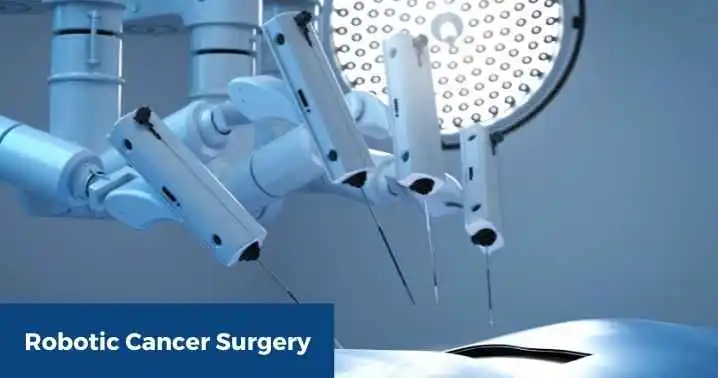- Home
- Robotic Cancer Surgery
Robotic Cancer Surgery

Traditional cancer surgery meant open surgeries with long incisions that are associated with significant pain and relatively slow recovery. With the advent and incorporation of minimal access surgery (keyhole surgery) in cancer treatment now it is possible to get all its benefits similar to non cancer surgeries.
Robotic surgery is the latest innovation in minimal access surgery where a robot is utilized to perform a precision surgery. Unlike the popular belief the robot does not operate in a robotic surgery !!! It’s still the surgeon who operates, but using a robot.
Another term for robotic surgery is robot-assisted surgery.
There are several unique features in a robotic surgical system.
Some of them are,
- 3-D vision
- Fine motion scaling – where the surgeon can scale down the magnitude of his hand movements
- Tremor elimination
- Stable platform that is not dependent on assistant surgeons and staff.
- Instruments that have 7 degrees of freedom similar to the human hand. This enables precision surgery in complex areas.
- Additional features to assess the blood supply to organs to ensure proper healing.
Your surgeon will determine whether you are the right candidate for robotic surgery for your particular cancer.
Based on your eligibility, your surgeon will design a surgical treatment plan that is ideal for your case.
What is the procedure for robotic surgery?
Robotic surgery is an advanced and innovative minimally invasive surgery where the surgeon sits on a computer (console) outside the operation theater to perform surgery with a computer-controlled robot.
The Da Vinci Surgical System is currently the only FDA-approved and commercially available robotic system globally. The assembly of the system includes:
Surgeon Console
Here the surgeon sits and controls the tools and instruments (robotic arm) while viewing the patients’ anatomy in a high definition 3D camera.
Patient Cart
It is positioned alongside the operating table in the surgical room. This cart holds a camera and instruments controlled by the surgeon from the console.
Vision Cart
This cart makes communication between various components and supports the 3D high-definition vision system.
Although each surgery is different, here are the general steps to be followed in a typical Robotic-assisted surgery:
First, the surgeon makes small (one to two centimeter-long) incisions (cuts) in the patient’s body.
Later, a powerful 3d camera is inserted into the body followed by other robotic instruments needed to carry out the surgical procedure. All these are connected to the patient cart (which we generally refer to as the robot).
The surgeon then sits at the console (a large computer) to perform the procedure. The operating areas appear highly magnified at the console, with high-level resolution.
At the console, the controls are manipulated by the surgeon.
The robotic instruments respond to the movements and translate them into accurate, real-time movements inside the patient’s body.
The robotic devices have more dexterity and a wide range of motion just like a human hand, allowing the surgeon to perform delicate surgeries in hard-to-reach places successfully.
Benefits of Robotic surgery
Many surgeons find the robotic arm used in robot-assisted surgery increases the control and precision of their movements during surgery. The robotic system’s 3-D viewer is a high-definition imaging technology that lets surgeons see the surgical site better than any other conventional magnification.
The advantages of robotic surgery over conventional surgery include:
- Smaller incisions
- Less scarring
- Reduced blood loss and pain
- Shorter hospital stays
- Low risk of postoperative infections and other complications
- Faster recovery and return to normal routine activities
- Improved quality of life
These benefits are more pronounced with complex, high-risk cancer surgeries.
Cancers treated with robotic surgery
Here are some cancers that can be easily treated with robot-assisted surgery:
- Colorectal – Robotic surgery is often considered ideal for treating colon and rectal cancer since these conditions require complex surgery.
- Gynecological – Several studies have shown the effectiveness of robotic surgery on several gynecological cancers.
- Head and neck – With robot-assisted surgery, surgeons can now reach many tumors through the oral cavity, also known as trans-oral robotic surgery (TORS).
- Pancreatic – Robotic surgery has proven effective for pancreatic, liver, and bile duct cancers.
- Thoracic (Esophageal and Lung) – A lot of cancers of the thoracic cavity like esophageal cancer, lung cancer, thymus, and other mediastinal (middle chest) tumors can be done with advanced invasive robotic surgery.
- Thyroid – Robotic surgery used to treat thyroid cancers shows fast healing with no visible scarring.
- Urological (Prostate) – Nowadays, robotic surgery is the standardized procedure of urological surgery specifically for prostate cancer.
Conclusion
Robotic surgery enables a radical operation with high precision in complex areas. This is because of enhanced 3d vision, fine motion scaling, and a stable platform. This is important in complex cancer surgeries.
For more information on robotic surgery, get in touch with our specialist now!

Why Dr. Ridham Shah
A Surgical Oncologist Practicing In The City Of Ahmedabad
- Experience of a decade in treating cancer
- Expertise in Laparoscopic cancer surgery, Robotic cancer surgery
- Expertise in Digestive System Cancers, Colorectal cancers , Peritoneal cancers, advanced abdominal cancers
- Expertise in Cytoreductive Surgery, HIPEC, PIPAC
- Excellent support staff to help you during treatment
- 360 degree care
Specialities

Ovary Cancer

Rectal Cancer

Colon Cancer

Endometrial Cancer

Liver Cancer

Esophageal Cancer

HIPEC Surgery

Robotic Surgery

Vulvar Cancer

Gallbladder Cancer

Stomach Cancer

Pancreatic Cancer

Cervix Cancer
